If Young.s double slit apparatus is shifted from air to water, then
fringe width decreases
fringe width increases
fringe width remains same
fringe system disappers
The correct Answer is:A
To solve the problem of how the fringe width in Young's double slit experiment changes when the apparatus is shifted from air to water, we can follow these steps:
Step 1: Understand the Formula for Fringe Width
The fringe width (β) in Young's double slit experiment is given by the formula:
β=λDd
where:
- β = fringe width
- λ = wavelength of the light used
- D = distance from the slits to the screen
- d = distance between the slits
Step 2: Effect of Medium on Wavelength
When the apparatus is shifted from air to water, the wavelength of light changes. The wavelength of light in a medium is given by:
λ′=λn
where:
- λ′ = wavelength in the medium (water)
- λ = wavelength in air
- n = refractive index of the medium (for water, n≈1.33)
Step 3: Substitute the New Wavelength into the Fringe Width Formula
When the apparatus is in water, the new fringe width (β′) can be expressed as:
β′=λ′Dd=(λn)Dd=λDnd
Step 4: Compare Fringe Widths
Now, we can compare the fringe widths in air and water:
- Fringe width in air: β=λDd
- Fringe width in water: β′=λDnd
Since n>1 (for water), it follows that:
β′<β
This means that the fringe width decreases when the apparatus is shifted from air to water.
Conclusion
Thus, the correct answer is that the fringe width decreases when Young's double slit apparatus is shifted from air to water.
---
The fringe width (β) in Young's double slit experiment is given by the formula:
β=λDd
where:
- β = fringe width
- λ = wavelength of the light used
- D = distance from the slits to the screen
- d = distance between the slits
When the apparatus is shifted from air to water, the wavelength of light changes. The wavelength of light in a medium is given by:
λ′=λn
where:
- λ′ = wavelength in the medium (water)
- λ = wavelength in air
- n = refractive index of the medium (for water, n≈1.33)
When the apparatus is in water, the new fringe width (β′) can be expressed as:
β′=λ′Dd=(λn)Dd=λDnd
Now, we can compare the fringe widths in air and water:
- Fringe width in air: β=λDd
- Fringe width in water: β′=λDnd
β′<β
This means that the fringe width decreases when the apparatus is shifted from air to water.
Thus, the correct answer is that the fringe width decreases when Young's double slit apparatus is shifted from air to water.
Topper's Solved these Questions
- WAVES OPTICSBook:AAKASH SERIESChapter:WAVES OPTICSExercise:EXERCISE -IA (DIFFRACTION)
Explore 33 Videos
- WAVES OPTICSBook:AAKASH SERIESChapter:WAVES OPTICSExercise:EXERCISE -IA (POLARASATION)
Explore 29 Videos
- WAVES OPTICSBook:AAKASH SERIESChapter:WAVES OPTICSExercise:EXERCISE -III (POLARISITION)
Explore 10 Videos
- WAVESBook:AAKASH SERIESChapter:WAVESExercise:EXERCISE-III (Doppler effect :)
Explore 15 Videos
Similar Questions
In Young's double slit experiment:
View SolutionIf the source of light used in a Young's Double Slit experiment is changed from red to blue, then
View SolutionWhen entire Young's double slit apparatus is immersed in a liquid the fringe width decreases by 20∘. The refractive index of the liquid is
View SolutionA Young's double slit experiment is performed with white light, then
View SolutionIf young's double slit experiment is performed in water
View SolutionIf the source of light used in a young's double slit experiment is changed from red to violet
View SolutionA Young's double slit apparatus has slits separated by 0.28 mm and a screen 48 cm away from the slits. The whole apparatus is immersed in water and the slits are illuminated by the red light (λ=700 nm in vacuum). Find the fringe-width of the pattern formed on the screen.
View SolutionA Young's double slit apparatus has slits separated by 0.25mm and a screen 48cm away from the slits. The whole apparatus is immersed in water and the slits are illuminated by the red light (λ=700nm in vacuum.) Find the fringe width of the pattern formed on the screen. (μw=4/3)
View SolutionIn the Young's double slit experiment apparatus shown in figure, the ratio of maximum to minimum intensity on the screen is 9. The wavelength of light used is λ, then the value of y is

View SolutionIf Young's double-slit experiment is performed under water, how would be observed interference pattern be affected ?
View Solution

